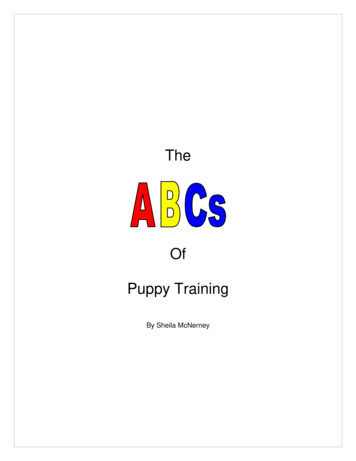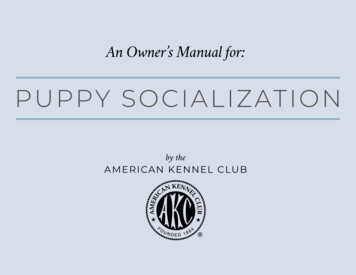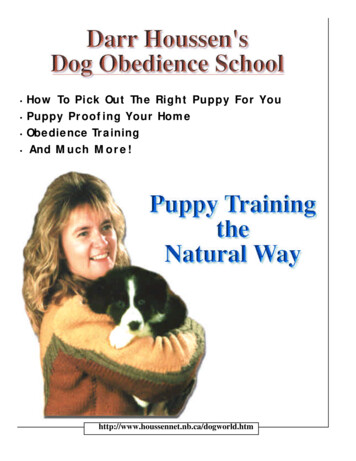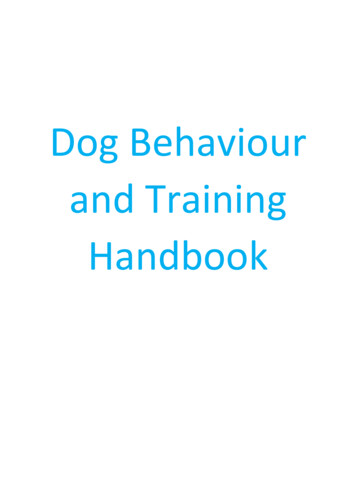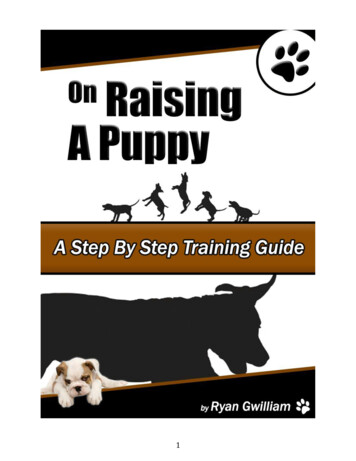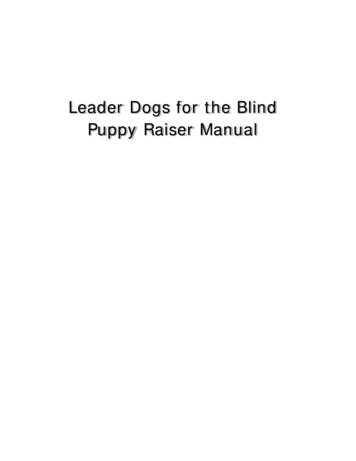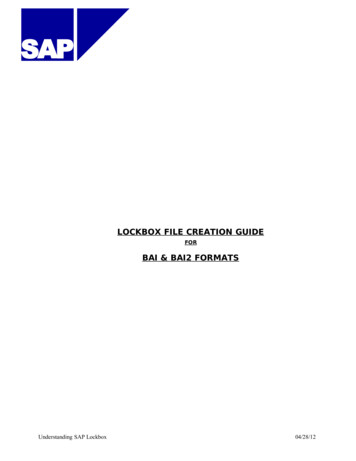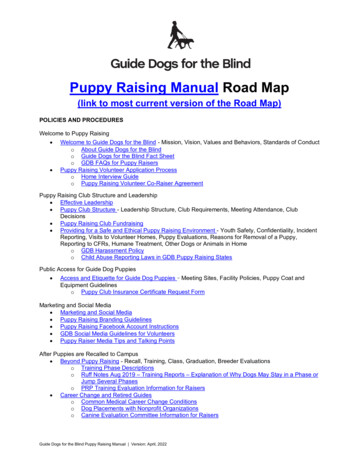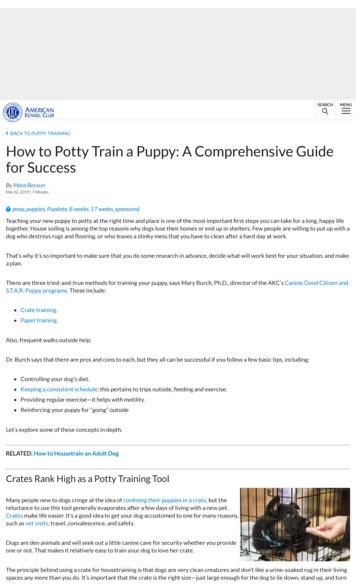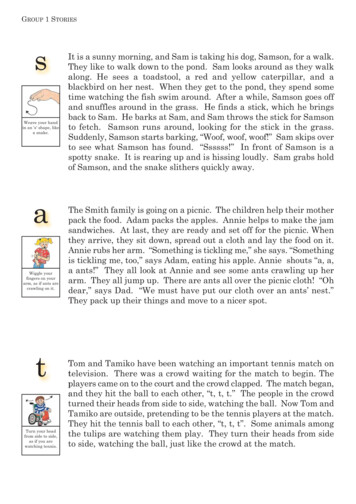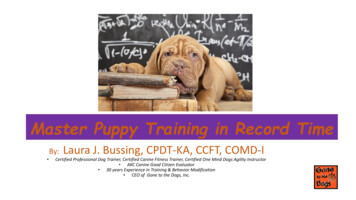
Transcription
Master Puppy Training in Record TimeBy: Laura J. Bussing, CPDT-KA, CCFT, COMD-ICertified Professional Dog Trainer, Certified Canine Fitness Trainer, Certified One Mind Dogs Agility Instructor AKC Canine Good Citizen Evaluator 30 years Experience in Training & Behavior Modification CEO of Gone to the Dogs, Inc.
ContentsPageBecoming a Dog Parent3 Things to Master Now!Potty TrainingCrate TrainingChewing DeterrenceBite InhibitionListeningCritical Elements DefinedSocializationSetting BoundariesBasic ObedienceClosing Comments345-89-1112-161718-202122-2829-3031-4041
Becoming a Dog ParentPuppies are such a wonderful adventure in love, happiness and a lotof patience! They fill our hearts with joy, bring a smile to our faces and atthe same time, challenge our patience. Of course, they don’t mean to; theysimply do not know better. As a new Dog Parent, it is your job to teach themhow to exist in the human world. They have just been plucked from thecanine world, so this endeavor will certainly take some time. Teaching yournew puppy the ways of the human world should be fun and gratifying. I lovetraining dogs more than doing anything else (which is a lot these days)! Theyare so eager to learn and more importantly, to please us. I want you toalways make sure you and your puppy are enjoying the process as youstrengthen your bond. The bond forged with a dog is like no other. Our dogstruly love us unconditionally. Soon, your puppy will be so crazy about youthat you will wonder why you didn’t get one sooner!
3 Things to Master Now!There are 3 major objectives toaccomplish right away with a newpuppy. You want them to: Stop pooping on your carpet! Stop chewing you & your things! Learning Rules – “Sorry!”I want to immediately help youresolve these issues. I’m sure you’retired of cleaning up poop & pee,right? So, let’s dive into these topissues first. Once you accomplishthese 3 important objectives, lifewill be much easier for you and yourpuppy. I’ll then move on tosocialization, setting boundaries andlearning obedience.
Potty TrainingAre you ready to get the potty training solutions you’ve beensearching for? By far, potty training or “housebreaking” isthe most important thing your puppy will ever learn. 8-12weeks of age is the optimal time for your puppy to learn. Ifyou approach potty training with consistency and dedication,good habits can form fairly soon. Although, you should beprepared for the occasional mishap. Dogs do not have fullbladder control until they are 5 months old.Never Punish! Do not wipe their nose infeces or urine. Trust me, they do notcomprehend! Just take your puppyoutside immediately & get them out fasternext time. Time to rethink the schedule!
Potty Training – When?Your puppy needs to use the potty frequently! When: He wakes in the morning or after any nap After all meals (feed on a schedule) After playing, exercise or excited times At least, EVERY HOUR At night, before bedtimeTake them outside and be prepared to waitfor “it” to happen. The world is an excitingplace to puppies, so he may be distracted,just be patient and “it” will come!
Potty Training – Look for thesigns:Watch your puppy carefully, and look for these sure signs: Stops playing or chewing Starts to sniff the floor Circles while sniffing Appears to have a distracted moment Wanders to an area where he’s gone before or near a doorBe Quick – have shoes & coat at the door!As soon as you observe the abovebehaviors, scoop up your puppy and getthem outside.
Potty Training–The Phrase that Pays:Reinforcing the right action, with the right phrase! Choose a phrase to say when your puppy “goes”“Hurry Up”, “Go Potty” – are some good onesEvery time he goes, say your phrase!Say the phrase as you let them out the door, “Hurry Up”Praise when he “goes” and give a treat reward too –Make sure to pick up the fecesWhy pick up POOP?1. Best sanitation for your family.2. Don’t give your puppy an opportunityto eat it – yes that’s gross and anothersubject all of it’s own!
The absolute key to Potty TrainingClick here for CrateTraining TIPSYep, a Crate is the key. Also known as aKennel, it will give your puppy a safeplace to hang out in your absence. Italso doubles as a “den”. Puppies aregenetically wired not to soil where theysleep. Tip: Crate too big for your smallpuppy? Use blocks to make it smaller.
Simple Crate TrainingDoDon’t Leave it open, let puppy sniff &enter on his own Put treats & safe toys inside Include items with your scent Place a drowsy puppy inside tosleep with door open Gradually accustom him to doorclosing Slowly build up time he spendsinside crate Force your puppy inside Shut him in right away Leave him for prolonged periodsshut inside Use the crate as punishment Leave soft toys that he can tear upand swallow
Potty Training - Summary Have a sense of humor & great patienceImplement a consistent feeding scheduleDo not give them the run of the houseBe proactive & vigilant about going outsideYou can only correct if you catch them in the actof going inside – with a strong “no”Use your phrase (hurry up) every timeBe a coach when you take them out, no matter theweather. Teach all family members what you learnBecome an expert in recognizing the signsHousebreaking is easy if you are vigilantDid I say have a sense of humor & great patience? Click Here for TIPS PAGE
Chewing the Right ThingRight! Puppy ToysWrong! Your stuffYou need an arsenal of durable, safe toys and natural chews at your disposal!
Chewing: Why do Puppies Chew?Boredom! No Exercise!Anxiety Relief! Teething Pain!Puppies just chew to chew! If they’re not sleeping, eating or pooping, they are chewing!
Chewing: Safety First First thing – you have to puppy proof your house! No exceptions. All humans in your house have to pledge to NOT leave their stuff onthe floor. It is extremely dangerous and unsafe. If you can’t keep your stuff picked up, be ready to take your puppy tothe VET to have these items surgically removed: underwear, socks,buttons, coins, paper clips, child toys, golf balls, etc. (I think you getthe picture) This is a huge safety issue – just like baby proofing! This includeselectrical cords & toxic substances (plants, liquids, etc).
Chewing: Guide to Good Habits Encourage them to chew their stuff only If you find your favorite item in their mouth, takeit away, tell them “Sorry” firmly (never shout, orhit them) Immediately give them a dog toy or chew thatthey are allowed to have. Figure out how they got your stuff (you hadpuppy proofed the house and picked up all yourstuff, right?) By consistently putting things in their mouthsthat is their “stuff”, that they LOVE, they will notwant your bland stuff. Choose only Durable, Non-toxic toysTip: Never leave a puppy alone for along time. If you use a crate, and yourpuppy is never bored, your couch willstill be fit for you to sit on!
Chewing: Supervision NeededGoodCold Pressed Rawhide islike a popsicle for yourpuppy. Only tiny bitscome off at a time,making it a safer, verydigestible chew. It is longlasting & superb dentalcare. My 2nd favoritechew are bully sticks.They don’t last as longbut are also easilydigestible.They dosmell, but are a pup fav!Never give your puppyrolled or knotted bonerawhide. It simply isnot safe, as large piecescan be chewed off at atime. These pieces maycause an intestinalBLOCKAGE that mayhave to be surgicallyremoved. Other badchews: chicken or porkbones (they shatter).Puppy teeth are not strong enoughfor hard bones.Tip: Supervise your puppy when chewing anything. Youshould assess what their level of destruction is & thendetermine what you can leave them with & for how long.Bad
Bite Inhibition – From Day 1 Sit down with the pup to play, bringing his attention to yourhands. When the pup tries to bite your hand too hard, yelp orsay ‘Ouch’ (high pitch) and stop all interaction. In addition tostopping interaction, pull your hands back and avert your eyesor look to the side, away from the puppy. The pup needs to learn that the fun stops when he bites. Give the pup a non-squeaking toy to chomp on instead of yourhands or clothing. If he does not take the toy and instead nipsagain, stop interacting. Turn away, cross your arms, do not lookback you can even walk away. After time has passed, engage your puppy again and offer yourhand. If he tries to bite, repeat the process. When your pup is gentle, pet and praise him calmly andresume play. As you practice, the pup will use less and lesspressure as he comes in contact with your hand.Do not tap or smack the dog’s nose aspunishment for nipping — instead ofdiscouraging nipping, this tends to triggerinstinctive self-defense biting. Daily groominghelps a dog get used to human touch. Teachyour pup early on to allow you to touch his faceand open his mouth. This will prepare him foractivities like vet exams and tooth brushing.
Listening: Learning “Sorry!”The first word your puppy shouldlearn is their name. The second wordwill be “Sorry”. I’m sure by now youhave told your puppy “no” a hundredtimes, but let’s change it to “Sorry”,because it just needs to signal thatthey shouldn’t be doing something.The word NO tends to get screamedand can be difficult for sensitivepuppies. Because of their curiousnature of the new human world, theyare going to do many things that youdo not want them to do.
Listening: It’s all about that ToneSo how do we teach them to listen? Simple. It’s all about your tone ofvoice. “It’s all about that tone, about that tone, no baby talk”. I knowI’m butchering a popular song! What I’m trying to get across is thatwhen you use the word “Sorry” you need to change your tone of voiceto a firm tone. Your main voice that you use with your puppy is a sweetvoice. If you say “Sorry!” in that sweet voice, your puppy will simplynot hear it as it sounded just like everything else. Example: “oh, what asweet baby, you are so cute! Now, Sorry, don’t jump on me”. Yourpuppy only heard a praising voice through all of that even though therewas the word “sorry” in it.
Listening: Canine Communication Canine communication is all about tone and bodylanguage. You can IGNORE your puppy by turning around, leaving theroom, removing what they want. Engage your puppy againand ask for a good behavior like sitting, instead of jumpingfor example. You will soon establish a clear line of communication thatyour puppy understands. Make sure every human in your household is notrewarding unwanted behavior: Either say “Sorry”, orignore it until you get desired behavior. My training philosophy is about working hard to get thebehavior I want instead of something undesirable. I simply ignore the “bad” behavior and I proactively ask forthe good behavior I want to train. I don’t give them timeto do the bad behavior.
The Next Critical Elements Socialization Setting Boundaries Obedience
Socialization – #1 Critical ElementTo Humans of all SizesTo Dogs of all SizesAnd to all types of life situations, sounds & sights!
Socialization: Get an Early start Start immediately @ 8-9 wks old PLEASE!!! Many puppies do not receive adequatesocialization at an early age, leading to problemslater on. There are potential health risks mixing with otherdogs, just take precautions ensuring that allinvolved dogs are current on shots. These minor risks do not outweigh the manyfuture behavioral problems you’ll encounter froman unsocialized puppy. I can’t emphasize enough how critical socializationwith friendly new dogs & humans is in thedevelopment of a well balanced dog. AND so doesthe American Veterinarian Association, see below https://avsab.org/wpcontent/uploads/2018/03/Puppy Socialization Position Statement Download - 10-3-14.pdfThis illustrates the proper meetingetiquette of all dogs: “Nose to Butt”,also known as the “circle greeting”
Socialization: How not to Meet a DogNotice that both dogs have very erect tails. Thedog on the left is standing extra tall & itshackles are up. Likely, this will erupt in a verystrong disagreement or fight. Please never letyour puppy go nose to nose. He may get toldby the other dog that it’s not the correctmeeting etiquette.Imagine a complete stranger quicklycoming up to you right in your face, withtheir nose touching yours. What wouldyou do? How would you feel? I know Iwould say “back off, you jerk!” and shovethem away.For dogs, it’s the same thing. Only dogsthat are friends meet nose to nose.Teach your puppy by physically showingthem how to do the circle greeting. Youmay need to present their rear for them!
Socialization: Preventing BadHabitsIf your puppy is rather confident and pesters yourolder or softer adult dog, you must step in and put astop to it. “Sorry!”. You want the dogs to interact butwhen it gets too unruly, call your puppy away or guidethem away for a time out. Go back to practicing biteinhibition.Your puppy will soon learn what type of play isacceptable. Such as playing with toys or chasing eachother. Excessive mouthing of another dog will result inthe end of play time.If your adult dog has poor social skills, take your puppyout without him. If the older dog has other dog issues,you want to make sure your puppy doesn’t learn thesebad habits.
Socialization: Meeting FriendlyStrangers Puppies should meet new humans asmuch as they meet new dogs. It’simportant for them to readily accepthumans of all sizes and gender.Especially kids. It’s also important for them to besubjected to joggers, cyclists,skateboarders,horseriders,groomers, vets, and pet sitters.Tip: Puppies should be held in all different kinds ofpositions. This helps desensitize them to handlingand also teaches trust . Check out this video:https://www.youtube.com/watch?v BWF5fv6TsyA&t 237s
Socialization: Free Puppy Social Time Gone to the Dogs hosts a FREEPuppy Socialization on Saturdays @ 9:00amat 235 W. Hwy 50, Salida, CO 8-16 weeks; Must have 1st shots (bring records) Explore our Store & meet other puppiesClick for Info & to Register
Socialization: Puppy Showers
Set Boundaries, Make RulesSet Boundaries Where they can go What they can lay on What they can chew on Where they sleep Walks on-leashMake Rules No jumping up No counter surfing No biting No leash pulling No excessive barking No mountingRules Good MannersTip: Providing your puppy with STRUCTURE is vital to raising adog that is completely comfortable with the world.
Boundaries: A few more RulesMore Rules No chasing the cat No chasing cyclists, joggers, etc. No chasing childrenImmediately use “Sorry!” when theabove occurs. Your Puppy’s preydrive is being triggered by therunning movement. Give them adifferent activity to do such aschasing a toy or ball.Rules Saves Lives!Tip: Early management of your puppy’s instinctual prey drive tochase things will pay off. So when they get bigger, they don’tchase cars, which can be deadly. They should LOVE chasing TOYS
Obedience: How to Begin Start Slow and Be RealisticTrain in short Bursts of 2 min.Use Positive ReinforcementUse Treats as RewardsUse a leash, even indoorsBe patient – your puppy has atiny attention span!
Obedience: Guidelines toTeaching Your puppy shouldn’t be tired Use a distraction-free location Praise & Reward with food or playingwith a favorite toy whenever the action isperformed correctly Practice regularly in short bursts Enjoy yourself, training should be joyous Take a break when frustrated Learn proper handling mechanics &timing through a professional trainer forbest results
Obedience: How PuppiesLearnBuild Results Based AssociationsPuppies build associations between events& their results. He remembers if an actionbrought a reward or not. He needs topractice an action often to do it reliablyMaximize Training Results Have high-value treat rewards readily avail. Lure your puppy with reward into positionQuickly reward when action completedLimit opportunities for undesirable actionsUse toys as a reward if your puppy is crazyabout a certain toy
Obedience: PositiveReinforcementCurrent Canine Behavioral Science has discovered thatdogs learn quicker with “Positive Reinforcement” thanolder forms of abusive dog training. This involves thehandler rewarding desirable behavior and not usingequipment that causes pain. Benefits of Positive Reinforcement MethodRapid learningBetter relationship that is without fearReduces “run away” or “lost” dogsDogs will want to repeat rewarding behaviorsDogs that are delighted to please you
Obedience: Sit! Get your puppy to look at you Move your hand slowly holding thetreat (lure) up & back over his head The MOMENT his bottom touches theground, give him the treat and praisehim enthusiastically. Repeat the first 3 things repetitively Add the verbal cue “Sit!”, saying it themoment the bottom is on the floor Practice a few times every day for 3minute sessionsIf your puppyrears up, you’reholding the treattoo high
Obedience: Down! Start at the Sitting position Hold treat (lure) close to the nose, drawthe nose down slowly to floor at amoderate angle Puppy will start following the treat,naturally going into a down position Reward when his belly is on the floor Give lots of praise! Practice first 3 items over & over Input the verbal cue “Down!” when thebelly is on the floorIt’s vital to movethe treat lureslowly, keepingthe nose engagedIf your puppystands up, thetreat lure is toofar away
Obedience: Leash Walking Leash Walking takes time to Master!Get a non-pulling type HARNESS. Puppies have weaktracheas that can be damaged. Recommend: PetSafe 3in 1 harness or a Ruffwear Front Range Harness (sold atboth of our stores)Be encouraging when you start walking, at first they mayonly take a few steps. USE TREATS to lure them to walkforward.Once they get the hang of it, then they want to checkout everything and you will feel them pulling.Use the no-pull Harness. At this stage of their life, wewant to encourage exploration. We do want them togarner confidence, so we need to be careful not tosquash their eagerness to understand the world.
Obedience: Training ClassesEnroll in an Obedience ClassOnce your puppy has grown up a bit (12-14weeks), you can start Basic Obedience Classat Gone to the Dogs. Sessions start every 6weeks. Our Training Program also hasAdvanced & Elite Obedience Classes as well.Click for Class InfoNEED HELP NOW?Private Lessons in your home are available.Sometimes you just need to consult aProfessional. We’re happy to help.Click here to RegisterThese dogs are in a “Down Stay”. 8 dogs lying side byside simultaneously on a stay is a very high level ofobedience. You’ll be there one day soon!
Mastering Puppy Training Here’s the big key!Take it slow! Most people want to teachtoo many cues too quickly.In the first couple of months, you’re doingwell to have a puppy that is housetrained,doesn’t chew your things and understandsthe Rules.Perfect “Sit!” and “Down!” They are thefoundation for other cues like “Stay” and“Here”, and other tricks.Please spend the majority of your timeSOCIALIZING your puppy to as many newhumans, dogs & life situations that youcan. IT is VITAL to them becoming aconfident, happy go lucky dog that hasnothing to fear.It’s possible to have a very obedient dog in yourhouse that behaves poorly everywhere else. Thisis a sure sign of a lack of socialization
Mastering Puppy TrainingI specifically have left out “Stay” and “Here”.They are the two hardest things for yourpuppy to learn, bar none. Puppies need todevelop more of an attention span to learn areliable stay or recall. Address these with aprofessional trainer who can guide you withthe tricky timing and mechanics associatedwith these cues. It’s easy to make mistakes.Enjoy the fantastic journey oftraining your puppy. Be patientand have fun!- Laura Bussing
Thank You!“Enjoy the fantastic journey of training your puppy. This brief Ebook is to get you off to a good start on that journey. Ifrequently tell my training clients that their dogs are a work inprogress until the day they are no longer with us. Be patient,have fun and enjoy being a Dog Parent! I hope to see you atour Free Puppy Social TIme with your young puppy or perhapsin our Obedience Classes with your older puppy. A formaleducation is important for all puppies”- Laura Bussing, CPDT-kA, CCFT, COMD-IThe Pack Leader in Canine Culture –2 LocationsGeri, Maggie, Rayn, Cam & Laura235 Hwy 50 Salida – 719-539-4220410 S. Hwy 24, BV – 719-966-5445
Potty Training Are you ready to get the potty training solutions you’vebeen searching for? By far, potty training or “housebreaking” is the most important thing your puppy will ever learn. 8-12 weeks of age is the optimal time for your puppy to learn. If you approach potty training
